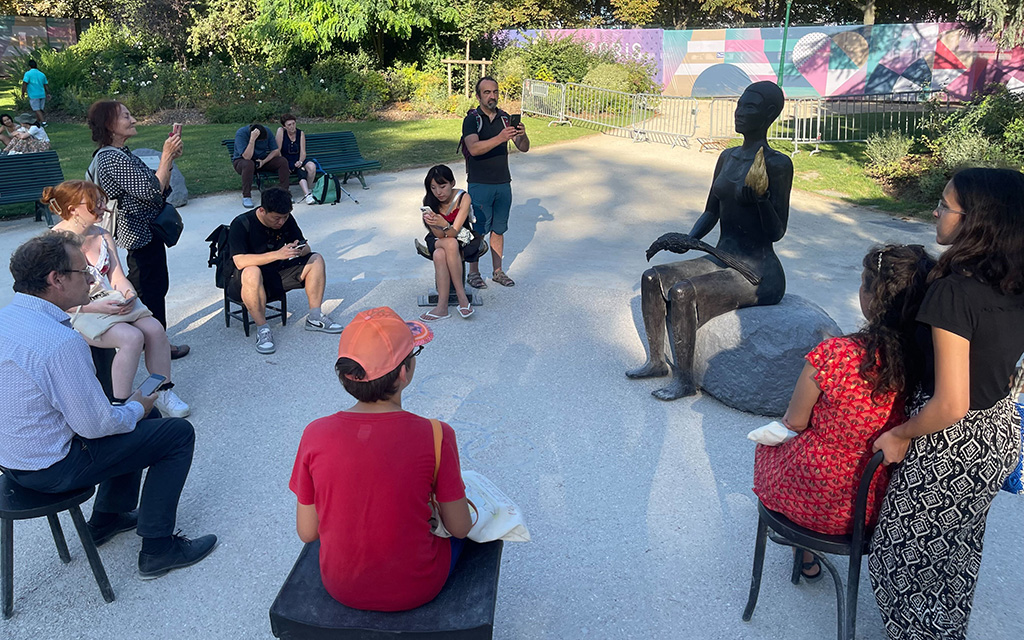
Passersby flock around the Olympic statue, “Salon,” to stop and take pictures or sit in one of its six chairs. The statue sends a strong message about inclusivity. (Photo by Melanie Hogue/Cronkite News)
PARIS – From this year’s Paralympics’ mascot proudly displaying a disability to the introduction of the first nursery in the Olympic Village, the Paris Games inspired conversations about inclusivity.
Although the Games are coming to a close, the discussion is far from over. Paris has long been a site of historic milestones for women, from Joan of Arc to Marie Curie. This year’s Olympics, the first to achieve full gender parity – an equal number of male and female athletes represented – marks significant progress since women were first allowed to compete in 1900, in Paris.
At the time, women only represented 2.2% of athletes and were limited to competing in tennis, sailing, croquet, equestrianism and golf. Today, that has expanded to 20 mixed gender events and 152 female competitions at this year’s Games, including triathlon, which has been put in the spotlight recently due to the controversy over swimming in the Seine River.
“That’s incredible,” Kirsten Kasper, Team USA triathlon athlete, said about the gender parity. “It’s amazing to see the development even from Tokyo three years ago. So, it’s really special to be a part of Paris and how that’s come about.”
For Kasper, making it to the Paris Games was a dream come true and her sole focus leading up to the Olympics. As she looks ahead, she knows she’ll need to take some time to reflect on what she wants to do next. But seeing peers such as Katie Zaferes and Gwen Jorgensen balancing family life and competing reassures Kasper that it might be possible for her, too.
While discussions of women having to choose between having a family and having a career are fewer, progress remains to be made for women in sports.
“The sweep of 125 years is a story of progress but it’s not full equity yet,” said Victoria Jackson, a clinical associate professor of history at Arizona State and accomplished athlete.
With approximately 10,500 athletes, Jackson stressed that “gender parity is not gender equality.” For one, the Olympics still work within a binary system, which can lead to gender policing, where women have to prove they’re “women enough” to compete.
But these are not the only issues women in sports face. Others include equal pay, medal opportunities, disparity with male athletes, bias, motherhood, women’s uniforms and more. So, while there’s excitement over this year’s historic milestone, there’s larger conversations around women in sports to be had.
To help ensure the discussion continues is “Salon,” the Paris Game’s Olympic sculpture. Commissioned by Alison Saar, a Los Angeles-based artist, Salon is meant to be a space that brings people of all different backgrounds together and offers them a seat at the table – quite literally.
“I think Salon represents, really, this idea of being generous and open to others unlike yourself,” Saar said. “Being open to understanding your differences. Maybe in some ways embracing your differences and that we’re each unique and really enriched by our cultural heritage.”
Near the foot of the Champs-Elysées, in the Charles Aznavour garden, a larger-than-life woman sits patiently, surrounded by six chairs, each representing a different region in the world. She is a Black woman of African ancestry, symbolizing how heroes come in all colors.
Though she never moves, her presence invites each passerby to pause. And pause they do. Whether to take a picture or a seat, Salon draws in a steady stream of visitors each day.
Victoria Guerard, 43, who stopped by Salon to take a picture with her three children, says she stopped because she recognized the woman at the center of this piece as someone approachable and of African descent, and it was important to explain to her kids what she was seeing.
“The freedom to come here, the tolerance, the integration of the continents, for me, is the most important,” Guerard said in Spanish. “Me, when I see it, it’s that. Because all types of people are a part of this.”
Salon is meant to serve as a crossroads where different worlds can meet, fostering new and old relationships. It’s a place built for spontaneous connections, a destination for artists and creatives and possibly performances. At the end of leaving Salon, it is Saar’s hope that people will break down boundaries and leave a bit more educated, enlightened and understanding, reflecting the true spirit of the Olympics.
As we look ahead to Los Angeles 2028, the legacy of Paris 2024 will continue to spark conversations around inclusivity in sports, and with “Salon” serving as a symbol for unity and diversity, it offers a reminder that everyone deserves a seat at the table.